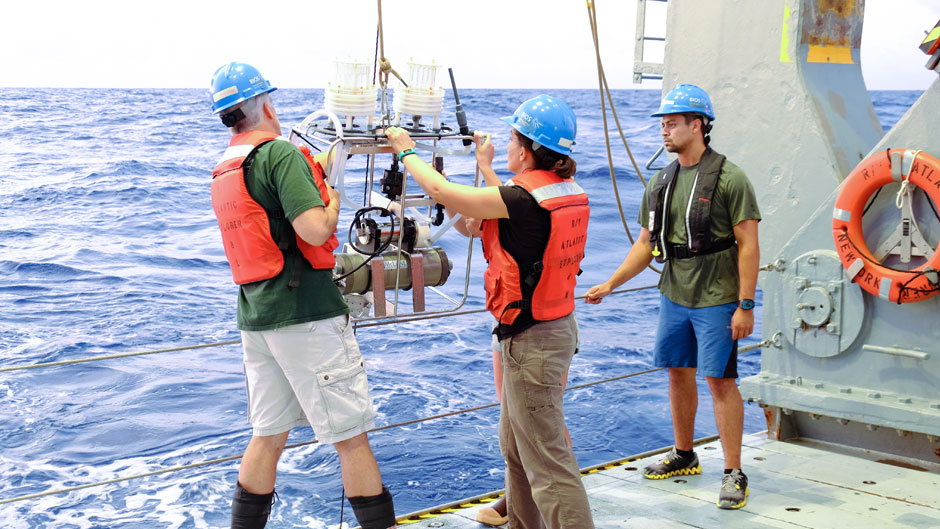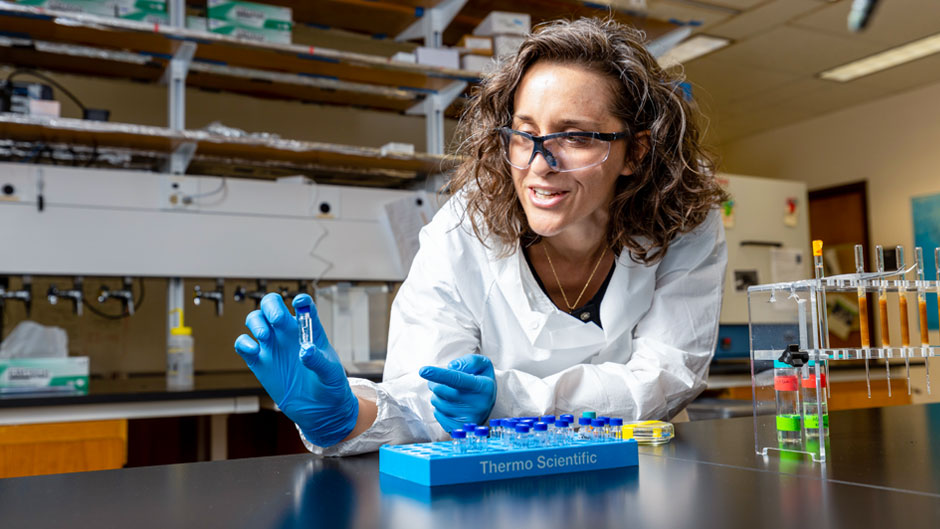When Hilary Close was in college, she was fascinated to learn that the Ohio farm she grew up on was once covered by a warm ocean, millions of years ago.
The discovery attracted her to the field of geology, which reveals important answers about the past that can also help scientists predict the future. Later, while studying rock samples that had fossils of marine life, Close developed a curiosity about the ocean.
Today, as an assistant professor of ocean sciences at the University of Miami Rosenstiel School of Marine and Atmospheric Science, Close studies the way that carbon from living organisms sinks into the deep ocean. Ultimately, this research helps scientists better understand how ocean ecosystems store carbon dioxide to support a cleaner atmosphere for those of us at the surface.
“The deep ocean is incredibly important in storing carbon because the water locks in things for hundreds of years and helps balance the carbon in the atmosphere,” said Close, a marine organic geochemist. “But when we think about the overall carbon cycle, living things are the wild card, so we want to know which processes control how much and what kinds of biological carbon get into the deep ocean.”
It is information that will help humanity understand the Earth’s carbon cycle, a delicate balance that scientists believe must be maintained to moderate climate change.
For her research and scholarship in the field, Close was recently named one of just eight Earth scientists to receive a prestigious Sloan Research Fellowship, awarded to 118 early-career scientists nationwide.

Rana Fine, a Rosenstiel School professor emerita who was on the search committee to hire Close, said the young researcher distinguished herself by developing a method that uses isotopes (found by measuring the atoms of chemical elements) to unlock information about our oceans. Using “compound-specific isotope analysis,” a rare technique employed by just a handful of geochemists, Close is analyzing the remains of tiny plants and animals that are able to sink into the deep ocean.
“This is important because it will help us learn whether certain forms of carbon are quickly buried and removed from the ocean, or whether they take thousands of years moving from one living organism to another,” said Fine.
Beyond that, Fine added, Close is a skilled teacher who is also able to juggle research, the development of new laboratory methods, and mentorship of students toward their own research careers. Her current colleagues, ocean sciences chair Brian Haus, and ocean sciences professor Dennis Hansell, agree.
Hansell and Close are both part of a small global network of scientists working to understand how the oceans absorb 25 percent of the carbon dioxide that humans release into the atmosphere. But while Hansell focuses on biological carbon that is produced in the upper ocean and is distributed with the currents, Close concentrates on particles of biological carbon that sink into the deep ocean from living things.
“It could be 1,000 years before carbon from the deep ocean comes back to the surface again, so the ocean provides a longer carbon sink than land does, but we still don’t know how long that is,” said Hansell. “We’re both looking at how carbon is biologically modified, and society needs to understand how this system works so that we can project threats, or opportunities, to conserve our oceans.”
Raised in rural northern Ohio, Close thrived as a geology major at Oberlin College but became increasingly interested in the ocean, as well as in chemistry..
For graduate school, she went on to Harvard University to study under professor Ann Pearson, one of the foremost chemical oceanographers in the nation. Pearson taught Close about compound-specific isotope analysis, which allows scientists to identify patterns that can help them understand what’s happening in a natural environment—ocean or otherwise, Close said. It also means she knows her way around an isotope ratio spectrometer, a massive machine that allows Close and her students to isolate these patterns.
“It’s a pretty uncommon technique, but we get so much data from this type of analysis,” she said. “For example, last year an undergraduate student did their honors thesis on deep sea mussels, and we did isotope analysis on the growth bands of its shell, which allowed us to make inferences about how the diet of that mussel was changing over its lifetime.”
After graduate school, Close did her postdoctoral training at the University of Hawaii. This allowed her to spend more than 100 days aboard research vessels in the Pacific and Atlantic Oceans. While there, she became even more proficient at using sampling pumps that can reach more than 1,000 meters under the ocean’s surface and filter out thousands of liters of water to collect a tiny circular sample of “biomass” from the deep ocean.
“If we can learn what organisms are important in different locations and depths of the ocean, it helps build the picture about the balance of carbon being produced and consumed from the surface ocean into the deep ocean,” she said. “Then, we can see how the community in the ocean is influencing how much carbon is sequestered in the deep ocean.”
Close said she will likely use some of the Sloan fellowship funding to enhance her sampling and analysis equipment. She would also like to do some more field research in the Atlantic Ocean, using the University’s research vessel, the F.G. Walton Smith, to work in the Florida Straits and other deep areas that can add more variety to her research, which has been focused on Bermuda and Hawaii. Close said a huge part of why she loves ocean research is the diversity of her findings.
“While geology is all about the past, it has similar concepts, and the field looks at patterns, like oceanographers do,” she said. “Because of my training, I can measure things happening in real-time and experiment with different ways of collecting samples in the ocean, so it’s been a great evolution for me, and I’m so glad to be a part of this field. The present-day ocean is constantly changing, and there’s always something new and different to explore.”

